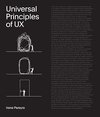Universal Principles of UX: 100 Timeless Strategies to Create Positive Interactions between People and Technology (Rockport Universal)
amazon.com
Saved by Alec Olschner and
Universal Principles of UX: 100 Timeless Strategies to Create Positive Interactions between People and Technology (Rockport Universal)

Saved by Alec Olschner and
And that’s a long time to deal with any red flags you chose to ignore when you agreed to do the work.
Red outline for the alternative path Rectangles for notes Diamonds for decisions
Whenever we design an interface that requires high learnability, we always look at computer games for inspiration. Game designers are extremely good at teaching complexity and giving the right kind of feedback at the right time so people aren’t even really aware they are learning something new.
Before we start any work, I always tell our clients that we are not—and will never be—the expert on their business. But we are the experts on moving them through a design process that will benefit their customers, which in turn will help their business. But to do that, we first need to dig into what the client is trying to achieve.
To brainstorm successfully, we only need three things: an hour to think on our own, an hour to think as a group, and a sketchbook. That’s it.
For this type of analysis, I am only interested in finding things that don’t work, are annoying, take too long, interrupt me, confuse me, or block me from continuing. Things that work well, I ignore. When I do encounter a usability fail, I take a screenshot, put that screenshot into a Keynote deck, and rate each usability fail based on the
... See moreThe way we design interfaces—and what we are used to and what we expect—has changed quite a lot since the first websites of the ‘90s, but one thing has remained the same, the positioning of the navigation. Put a website from 1999 next to a website from today, and you’ll see how the placement of the navigation is the only constant. Sure, the design
... See moreLower expectations for high satisfaction.
In our studio, by the time we start designing, we have already mapped out all the features and know which devices are most common for our users. This knowledge allows us to make device-specific design decisions based on real requirements and device usage, giving us a higher chance a design that performs well on all of the devices needed.